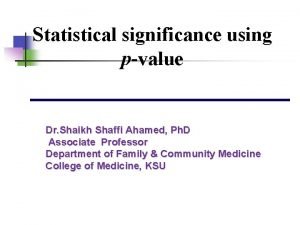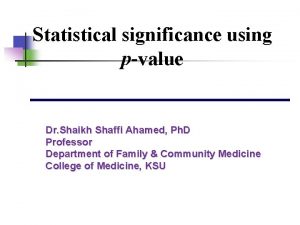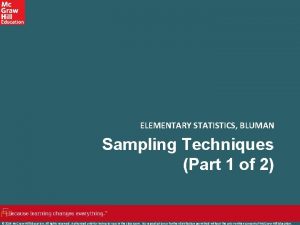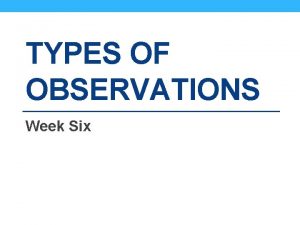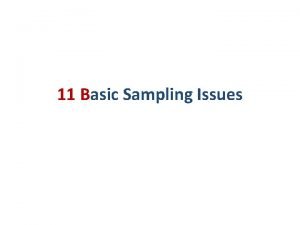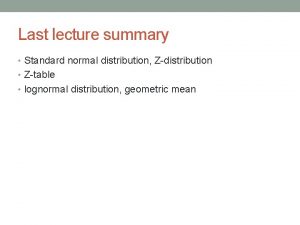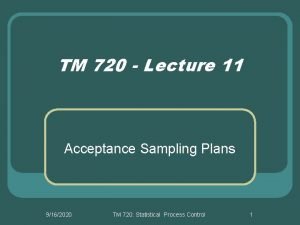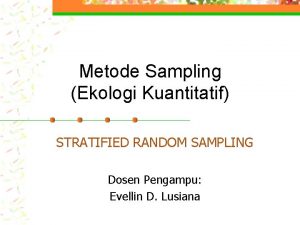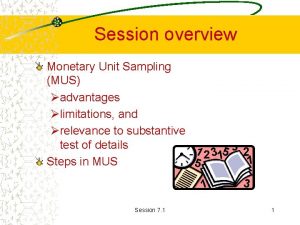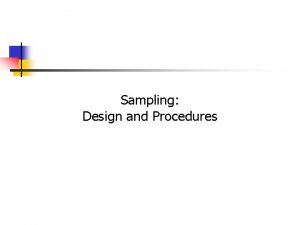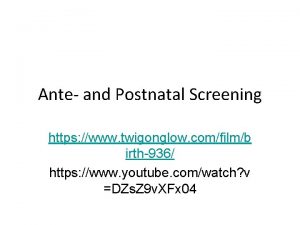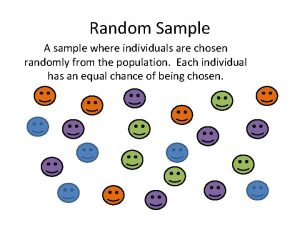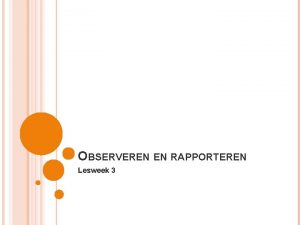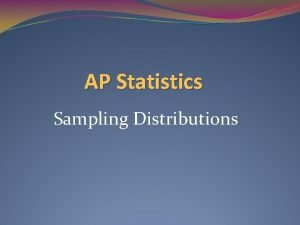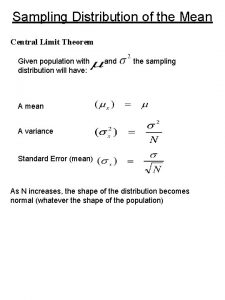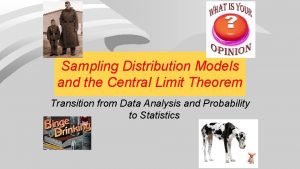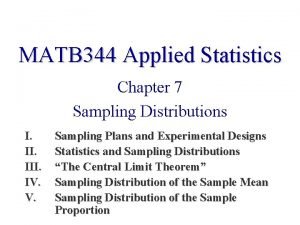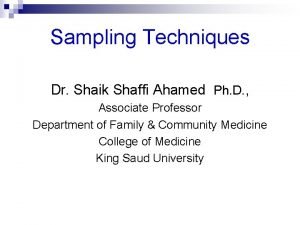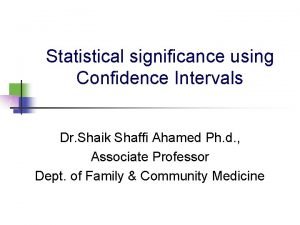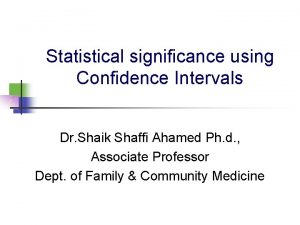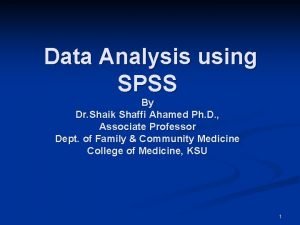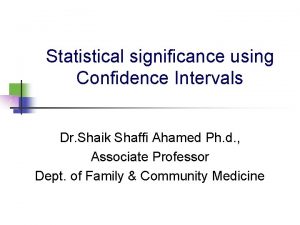Sampling Techniques Dr Shaik Shaffi Ahamed Ph D















































- Slides: 47

Sampling Techniques Dr. Shaik Shaffi Ahamed Ph. D. , Associate Professor Department of Family & Community Medicine College of Medicine King Saud University

Objectives of this session: Students able to (1) Understand meaning of sampling process and its importance n (2) Know the definations of different terms used in the sampling process n (3) Learn how to apply different random sampling & non random sampling techniques n

Sampling in Epidemiology n Why Sample? ¨ Unable to study all members of a population ¨ Reduce bias ¨ Save time and money ¨ Measurements may be better in sample than in entire population ¨ Feasibility

Sampling is the process or technique of selecting a sample of appropriate characteristics and adequate size.

Representativeness (validity) A sample should accurately reflect distribution of relevant variable in population n Person e. g. age, sex Place e. g. urban vs. rural Time e. g. seasonality Representativeness essential to generalise Ensure representativeness before starting, Confirm once completed

Sampling and representativeness Sampling Population Sample Target Population Sampling Population Sample

Definitions Population – group of things (people) having one or more common characteristics n Sample – representative subgroup of the larger population n ¨ Used to estimate something about a population (generalize) ¨ Must be similar to population on characteristic being investigated

Population: a set which includes all measurements of interest to the researcher (The collection of all responses, measurements, counts that are of interest) Sample: A subset of the population or

Def. – Cont. Sampling Frame • This is the complete list of sampling units in the target population to be subjected to the sampling procedure. • Completeness and accuracy of this list is essential for the success of the study. Sampling Units These are the individual units / entities that make up the frame just as elements are entities that make up the population.

Def. – Cont. Sampling Error This arises out of random sampling and is the discrepancies between sample values and the population value. Sampling Variation n Due to infinite variations among individuals and their surrounding conditions. n Produce differences among samples from the population and is due to chance.

n Example: In a clinical trail of 200 patients we find that the efficacy of a particular drug is 75% If we repeat the study using the same drug in another group of similar 200 patients we will not get the same efficacy of 75%. It could be 78% or 71%. “Different results from different trails though all of them conducted under the same conditions”

How to sample ? In general, 2 requirements 1. Sampling frame must be available, otherwise develop a sampling frame. 2. Choose an appropriate sampling method to draw a sample from the sampling frame.

The Sampling Design Process Define the Population Determine the Sampling Frame Select Sampling Technique(s) Determine the Sample Size Execute the Sampling Process

Sampling Methods n n n Probability Sampling Simple random sampling Stratified random sampling Systematic random sampling Cluster (area) random sampling Multistage random sampling Non-Probability Sampling n Deliberate (quota) sampling n Convenience sampling n Purposive sampling n Snowball sampling n Consecutive sampling

Simple Random Sampling n n Equal probability Techniques ¨ Lottery method ¨ Table of random numbers n Advantage ¨ Most n representative group Disadvantage ¨ Difficult to identify every member of a population

Table of random numbers 684257954125632140 582032154785962024 362333254789120325 985263017424503686

Random Number table 1 2 3 4 5 49486 93775 88744 80091 92732 94860 36746 04571 13150 65383 10169 95685 47585 53247 60900 12018 45351 15671 23026 55344 45611 71585 61487 87434 07498 89137 30984 18842 69619 53872 94541 12057 30771 19598 96069 89920 28843 87599 30181 26839 32472 32796 15255 39636 90819

How to select a simple random sample 1. 2. 3. n Define the population Determine the desired sample size List all members of the population or the potential subjects For example: 4 th grade boys who have demonstrated problem behaviors ¨ Lets select 10 boys from the list ¨

Potential Subject Pool 1. Ahamed 2. Munir 3. Khalid 4. Ameer 5. Junaid 6. Khadeer 7. Shaffi 8. Rafi 9. Ghayas 10. Fayaz 11. 12. 13. 14. 15. 16. 17. 18. 19. 20. Riyaz Yaseen Jaffar Sattar Ghouse Imran Khaleel Shabu Shanu Javid 21. 22. 23. 24. 25. 26. 27. 28. 29. 30. Fahad Iqbal Jabbar Aziz Anwar Shohail Shohaib Rehaman Naeem Rahim

So our selected subjects are with numbers 10, 22, 24, 15, 6, 1, 25, 11, 13, & 16. 1. Ahamed 2. Munir 3. Khalid 4. Ameer 5. Junaid 6. Khadeer 7. Shaffi 8. Rafi 9. Ghayas 10. Fayaz 11. 12. 13. 14. 15. 16. 17. 18. 19. 20. Riyaz Yaseen Jaffar Sattar Ghouse Imran Khaleel Shabu Shanu Javid 21. 22. 23. 24. 25. 26. 27. 28. 29. 30. Fahad Iqbal Jabbar Aziz Anwar Shohail Shohaib Rehaman Naeem Rahim

EPITABLE: random number listing

EPITABLE: random number listing Also possible in Excel

n Simple random sampling Estimate hemoglobin levels in patients with sickle cell anemia Determine sample size Obtain a list of all patients with sickle cell anemia in a hospital or clinic Patient is the sampling unit Use a table of random numbers to select units from the sampling frame Measure hemoglobin in all patients Estimate the levels (normal & abnormal) of hemoglobin ¨ 1. 2. 3. 4. 5. 6.

Systematic random Sampling n Technique ¨ n Advantage ¨ n Use “system” to select sample (e. g. , every 5 th item in alphabetized list, every 10 th name in phone book) Quick, efficient, saves time and energy Disadvantage Not entirely bias free; each item does not have equal chance to be selected ¨ System for selecting subjects may introduce systematic error ¨

Example n n n If a systematic sample of 500 students were to be carried out in a university with an enrolled population of 10, 000, the sampling interval would be: I = N/n = 10, 000/500 =20 All students would be assigned sequential numbers. The starting point would be chosen by selecting a random number between 1 and 20. If this number was 9, then the 9 th student on the list of students would be selected along with every following 20 th student. The sample of students would be those corresponding to student numbers 9, 29, 49, 69, . . . . 9929, 9949, 9969 and 9989.

Systematic sampling

Systematic sampling n N = 1200, and n = 60 sampling fraction = 1200/60 = 20 n List persons from 1 to 1200 n Randomly select a number between 1 and 20 (ex : 8) 1 st person selected = the 8 th on the list 2 nd person = 8 + 20 = the 28 th etc

Stratified Random Sampling n Technique ¨ Divide population into various strata ¨ Randomly sample within each strata ¨ Sample from each strata should be proportional n Advantage ¨ Better in achieving representativeness on control variable n Disadvantage ¨ Difficult to pick appropriate strata to Identify every member in population

Stratified Random selection for drug trail in hypertension Mild Moderate Severe

Sampling in Epidemiology n Stratified random sample ¨ 1. 2. 3. 4. 5. Assess dietary intake in adolescents Define three age groups: 11 -13, 14 -16, 17 -19 Stratify age groups by sex Obtain list of children in this age range from schools Randomly select children from each of the 6 strata until sample size is obtained Measure dietary intake

Cluster (Area) random sampling n Randomly select groups (cluster) – all members of groups are subjects n Appropriate when ¨ you can’t obtain a list of the members of the population ¨ have little knowledge of population characteristics ¨ Population is scattered over large geographic area

Cluster sampling Section 1 Section 2 Section 3 Section 5 Section 4

Cluster (Area) Sampling n Advantage ¨ More practical, less costly Conclusions should be stated in terms of cluster (sample unit – school) n Sample size is number of clusters n

Multistage random sampling n Stage 1 ¨ randomly n sample clusters (schools) Stage 2 ¨ randomly selected sample individuals from the schools

Sampling Methods n n n Probability Sampling Simple random sampling Stratified random sampling Systematic random sampling Cluster (area) random sampling Multistage random sampling Non-Probability Sampling n Deliberate (quota) sampling n Convenience sampling n Purposive sampling n Snowball sampling n Consecutive sampling

Deliberate (Quota) Sampling n n Similar to stratified random sampling Technique ¨ Quotas set using some characteristic of the population thought to be relevant ¨ Subjects selected non-randomly to meet quotas (usu. convenience sampling) n Disadvantage ¨ selection bias ¨ Cannot set quotas study for all characteristics important to

Convenience Sampling “Take them where you find them” nonrandom n Intact classes, volunteers, survey respondents (low return), a typical group, a typical person n Disadvantage: Selection bias n

Purposive Sampling n Purposive sampling (criterion-based sampling) ¨ Establish criteria necessary for being included in study and find sample to meet criteria n Solution: Screening Obtain a sample of larger population and then those subjects that are not members of the desired population are screened or filtered out ¨ EX: want to study smokers alone. ¨

Snowball Sampling In snowball sampling, an initial group of respondents is selected. ¨ After being interviewed, these respondents are asked to identify others who belong to the target population of interest. ¨ Subsequent respondents are selected based on the referrals.

Consecutive sampling ¨Outcome of 1000 consecutive patients presenting to the emergency room with chest pain ¨Natural history of all 125 patients with HIV-associated TB during 5 year period Explicit efforts must be made to identify and recruit ALL persons with the condition of interest

Choosing probability vs. non-probability sampling method Probability sampling Conclusive Larger sampling errors Evaluation Criteria Non-probability sampling Nature of research Exploratory Relative magnitude sampling vs. non-sampling error Larger non-sampling error High [Heterogeneous] Population variability Low [Homogeneous] Favorable Statistical Considerations Unfavorable High Sophistication Needed Low Relatively Longer High Time Budget Needed Relatively shorter Low

Suniti Solomon et al Prevalence and risk factors of HIV 1 and HIV 2 infection in Urban and rural areas in TN. TN Int. J. of STD & AIDS 1998; 9: 98103 Objective: Find prevalence and risk factors. Setting: Centres in metropolitancity & municipality. Subjects: Individuals in Tamil nadu. Sampling Porcedure: “ Health camps were organised in 5 urban and 5 rural centres to cover entire state graphically” “ Every third person screened, in the active reproductive age group, were recruited as a subject. At each camp the inclusion of subjects continued until 200 persons were recruited”

Mary Sexton et al. Sex differences in the use of asthma drugs: Cross-sectional study. BMJ 1998; 317: 1434 -7 Objective : To assess the use of asthma drugs. Design : Cross-sectional study. Setting: Six general practices in East Anglia. Subjects : Adults aged 20 -54 with Asthma Sampling method “identify cases with asthma received drugs one year before – through database from each participating practices. The sample was stratified into three categories of severity corresponding the prescribed drugs Bronchodilator alone (mild) 38% Steroids (moderate) 57% Nebulizer treatment (severe) 5% Use SRS to select subject in each practice based on proportion of use of each type of drug within the practice

S. Anuradha Genital ulcer disease and acquisition of HIV infection. Indian J Med Microbiol 1992; 10(4): 265 -269 Objective : To find out the association of HIV infection with genital ulcer disease. Setting : Dept. of STD, GGH, Chennai. Subjects : Individials attending the STD dept. Sampling procedure ‘ Blood samples from first 20 patients were taken for analysis once a week for 40 weeks’. Statistical analysis : Data were analysed by using SPSS/PC + ver 4. 0. The strength of association between the variables and HIV serological status was estimated using odds ratio (OR) and their 95% Confidence Intervals(CI)

Reidy A et al. Prevalence of series eye disease and visual impairement in a north London population: Population based, cross sectional study. BMJ 1998; 316: 1643 Objective: To estimate eye disorders and of visual impairement Design: Cross-sectional survey. Setting : General Practices in metropolitan in England. Subjects: aged 65 or older & registered

Sampling Procedure 17 general practice group Random sampling 7 were selected People age 65 or older were registered with the general practices. Total 750 -850 in each Gen Pract Use SRS to select eligible people in each practice One third in each practices were selected to form survey sample

In Conclusion, For any research, based on its study design and objectives an appropriate random sampling technique should be used, so as to generalize the findings.
 Shaik mohammad tajuddin
Shaik mohammad tajuddin Dr darez ahamed ias
Dr darez ahamed ias Objectives of the study
Objectives of the study Shaffi goldwasser
Shaffi goldwasser Dr shaffi
Dr shaffi Dr. shaffi
Dr. shaffi Interpreting p value
Interpreting p value Dr shaffi
Dr shaffi Significance and confidence level
Significance and confidence level Shaffi goldwasser
Shaffi goldwasser Dr shaffi
Dr shaffi Cluster sampling vs stratified random sampling
Cluster sampling vs stratified random sampling Contoh time sampling dalam observasi
Contoh time sampling dalam observasi A consumer confidence researcher asks several retailers
A consumer confidence researcher asks several retailers Sampling frame definition in research
Sampling frame definition in research Multistage sampling
Multistage sampling Natural sampling vs flat top sampling
Natural sampling vs flat top sampling Cluster sampling
Cluster sampling Sampling techniques
Sampling techniques Sampling methods psychology
Sampling methods psychology Sampling techniques in qualitative research
Sampling techniques in qualitative research Sampling techniques
Sampling techniques Sampling techniques
Sampling techniques Sampling techniques in research example
Sampling techniques in research example Fonctions techniques
Fonctions techniques Types of categories
Types of categories Skc air sampling
Skc air sampling Quita sampling
Quita sampling Byui applet
Byui applet Split tube thief is used for sampling of
Split tube thief is used for sampling of Acceptance sampling procedure
Acceptance sampling procedure Alokasi neyman
Alokasi neyman Mus sampling
Mus sampling Ltpd table
Ltpd table Types of sample design
Types of sample design Phenylketonuria is autosomal or sexlinked
Phenylketonuria is autosomal or sexlinked Progressive sampling
Progressive sampling As9138
As9138 Random m&m generator
Random m&m generator Audit sampling definition
Audit sampling definition Continue observatie
Continue observatie Ap statistics sampling distributions
Ap statistics sampling distributions Central limit theorem standard error
Central limit theorem standard error Safety sampling
Safety sampling Sampling distribution of variance
Sampling distribution of variance Central limit theorem
Central limit theorem Sampling distribution of p hat
Sampling distribution of p hat Lottery sampling
Lottery sampling






